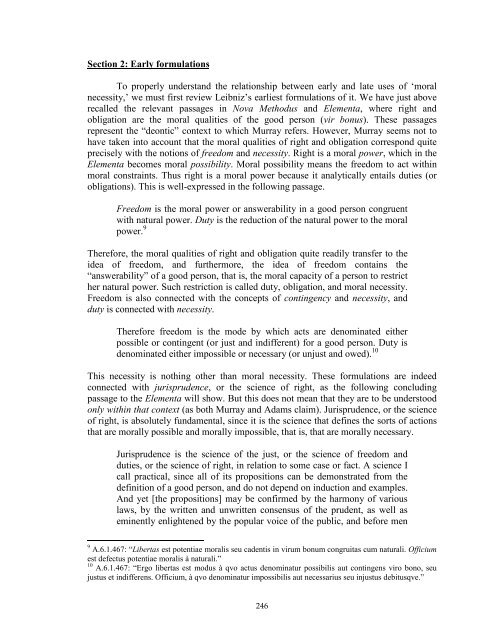Stony Brook University
Stony Brook University
Stony Brook University
Create successful ePaper yourself
Turn your PDF publications into a flip-book with our unique Google optimized e-Paper software.
Section 2: Early formulations<br />
To properly understand the relationship between early and late uses of ‘moral<br />
necessity,’ we must first review Leibniz’s earliest formulations of it. We have just above<br />
recalled the relevant passages in Nova Methodus and Elementa, where right and<br />
obligation are the moral qualities of the good person (vir bonus). These passages<br />
represent the “deontic” context to which Murray refers. However, Murray seems not to<br />
have taken into account that the moral qualities of right and obligation correspond quite<br />
precisely with the notions of freedom and necessity. Right is a moral power, which in the<br />
Elementa becomes moral possibility. Moral possibility means the freedom to act within<br />
moral constraints. Thus right is a moral power because it analytically entails duties (or<br />
obligations). This is well-expressed in the following passage.<br />
Freedom is the moral power or answerability in a good person congruent<br />
with natural power. Duty is the reduction of the natural power to the moral<br />
power. 9<br />
Therefore, the moral qualities of right and obligation quite readily transfer to the<br />
idea of freedom, and furthermore, the idea of freedom contains the<br />
“answerability” of a good person, that is, the moral capacity of a person to restrict<br />
her natural power. Such restriction is called duty, obligation, and moral necessity.<br />
Freedom is also connected with the concepts of contingency and necessity, and<br />
duty is connected with necessity.<br />
Therefore freedom is the mode by which acts are denominated either<br />
possible or contingent (or just and indifferent) for a good person. Duty is<br />
denominated either impossible or necessary (or unjust and owed). 10<br />
This necessity is nothing other than moral necessity. These formulations are indeed<br />
connected with jurisprudence, or the science of right, as the following concluding<br />
passage to the Elementa will show. But this does not mean that they are to be understood<br />
only within that context (as both Murray and Adams claim). Jurisprudence, or the science<br />
of right, is absolutely fundamental, since it is the science that defines the sorts of actions<br />
that are morally possible and morally impossible, that is, that are morally necessary.<br />
Jurisprudence is the science of the just, or the science of freedom and<br />
duties, or the science of right, in relation to some case or fact. A science I<br />
call practical, since all of its propositions can be demonstrated from the<br />
definition of a good person, and do not depend on induction and examples.<br />
And yet [the propositions] may be confirmed by the harmony of various<br />
laws, by the written and unwritten consensus of the prudent, as well as<br />
eminently enlightened by the popular voice of the public, and before men<br />
9<br />
A.6.1.467: “Libertas est potentiae moralis seu cadentis in virum bonum congruitas cum naturali. Officium<br />
est defectus potentiae moralis à naturali.”<br />
10<br />
A.6.1.467: “Ergo libertas est modus à qvo actus denominatur possibilis aut contingens viro bono, seu<br />
justus et indifferens. Officium, à qvo denominatur impossibilis aut necessarius seu injustus debitusqve.”<br />
246
















